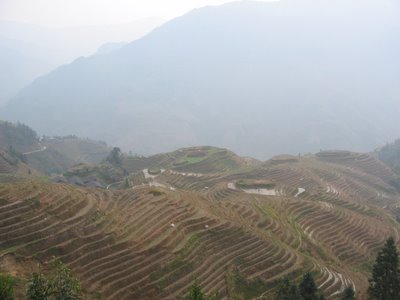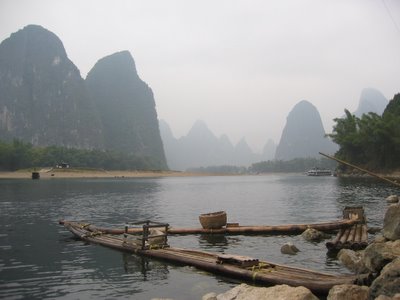It often seems that the most interesting travel events occur not at the destinations, but on the public transport between them. Once again this was true for this leg of our journey, perhaps not surprisingly as between Dali and Longsheng we spent 55 hours without a home and two nights in a row sleeping on trains.

A couple of old dudes in Ping An Village
The second of our back to back train trips we shared our bunks with a grandmother and two of her grandkids who at first seemed extremely cute, although unfotunately this impression didn't last for long... it may have had something to do with the fact that they were continuously fed a diet of sugar (not helped by Aimes giving them 'darn tarts') but before long they were alternating between screaming with joy and bawling their eyes out on about a 10 minute cycle (for a 19 hour train trip!). Perhaps the highlights were them using the bin that sits between the beds as a toilet and them screwing up mandarin and then throwing it all over the window to make them stick. Although they did have some redeeming cute qualities including using Pepsi bottles as dolls (even if they did bounce them on the ground a lot).
The other interesting sight on the train trip was quite a few men washing their feet and socks in the sink before they went to bed, this despite the fact that they looked as though they hadn't showered in weeks - why, we do not know?

The Dragon's Backbone Rice Terraces
So after being dropped at the Guilin North Station (we stopped at the main station for 30 minutes but they wouldn't let us off??) it was only another 2 hours on a bus before we arrived at Longsheng in northern Guangxi. So after about 55 hours without a home we finally arrived in Longsheng and after a bit of walking around town managed to find a decent hotel.

More Dragon's Backbone Rice Terraces

Unfortunately for us we didn't see the terraces in their best light as the rice had been harvested and there was a pretty thick haze that day, yet despite this they were still quite amazing. Every piece of land has been covered with them, even the very peaks of the hills.

Long Ji Village
 Ping An Village
Ping An Village
As with most tourist sights in China the main vantage points were packed with Chinese tourists, doing the usual things like being loud, walking in front of your photos and pushing. But it didn't take long to get away from them (partially because the sedan chairs they were carried up in couldn't handle the off road :) A number of small villages are scattered amongst the terraces and we did a bit of walk through them (after a false start almost had us walking into the next valley). It was really nice to be able to make your own way through the rice fields and see some relatively remote villages which are all perched precariously on the side of the mountain.
We were quite impressed with the fact that we managed to find our way back down to the road without falling into a rice paddy or being bitten by one of the many dogs and were even able to flag down a bus heading to Longsheng (we must be almost fluent at reading chinese :P). The bus back was a bit slow as at one point we were stuck behind another bus which had taken out some powerlines which were now entangled in its roof rack - fortunately no electrocutions ensued!
 The view from our guesthouse in Yangshou
The view from our guesthouse in Yangshou
A Yangshou laneway
Yangshou is described as a backpackers mecca, and it is true that it is full of tourists, although it is nothing like Koh San Road (Bangkok) or De Tham Street (Saigon) when it comes to ghetto-ness. Still it does have several aspects which make it quitessential backpacker land, pirated DVDs, pizza, lots of bars with very long happy hours and people ripping you off left right and centre. The internet cafe had a piece of paper with the price written on it which was flipped over to reveal a cheaper price when you walked out in protest of the first...
Anyways, the relaxed atmosphere, warmer weather, cheap food and beers and redily available DVDs made for a very nice change from the previous couple of months and resulted in not a great deal getting done for the first couple of days. We even continued to use the pool table on the rooftop of our hostel despite the fact that the felt was of the shag pile variety, the legs were precariously balanced on piles of old tiles and your line of sight was obscured by hanging washing. It was also nice to have a few familiar faces about as it seemed quite a lot of the people we had met in western China (one couple, the Isr-aliens, Miki and Riki) had stayed on in Yangshou longer than planned and Patrick (from our Mongolia trip) were passing through just as we were. It makes for quite a change to walk past a cafe and see familiar faces after so many weeks of just the two of us :)
 Karsts along the Yulong River
Karsts along the Yulong River
In amongst all the DVDs, pool, pizza and beer we did mange to drag ourselves on a bit of a bike ride through the limestone scenery which surrounds Yangshou. The scenery is truely amazing, even after having seen similar limestone karst formations in Krabi (Thailand), Vang Vieng (Laos), Halong Bay (Vietnam) and Hon Chong (Mekong Delta, Vietnam), the sheer scale of the karsts around Yangshou is incomparable. They continue for the entire length of the road between Guilin and Yangshou (80km) and as far as the eye can see from the top of any mountain that we scaled.
 The Li River
The Li River
In contrast to the pool table at our guesthouse the bikes on offer are pretty good quality, featuring dual suspension and gears that actually work. After riding out to Moon Hill, one of the more renowned hills, and being followed up all the 1000 steps by a woman trying to sell us water (she did succeed in the end, at a bit of a premium above the usual price - 'I have to carry up hill! very difficult!'), we decided to ride the length of a small creek through some small villages.
The road was very nice, flat, few cars, rice fields all around with the ever-present karsts rising between them (the entreprenaurial spirit wasn't far away though as a farmer wanted 2 yuan for Hobbes to take a photo of his buffalo!). However it wasn't long until we reached our first obstacle which was a river crossing without a bridge. Unsurprisingly though there was someone nearby eager to raft us across ('bamboo!bamboo!'), and after managing to precariously balance our bikes on the raft and get on without tipping them into the river we were soon across. The river is popular for rafting (the slow gentle, not white water variety) and there was a woman in the middle selling drinks who immediately started yelling 'pee jyo' (beer) when she saw Hobbes - his reputation obviously proceeds him :)
 Our bikes cross the Yulong River
Our bikes cross the Yulong River
After passing this obstacle a few more were thrown up including several small villages with several roads in and out. After stretching our extremely limited Mandarin to it's limits we managed to negotiate the first couple, until we came to the final one where we encountered 2 other western couples riding in various directions trying to find a way through. It seemed the village was a bit of a blackhole swallowing up tourists.
 Lost?
Lost?
After overcoming this last obstacle we arrived at our destination - a 600 year old stone bridge, which while impressively old and in great condition seemed a little bit of a let down after riding so far :(

The 600 year old Dragon Bridge
 Back streets of Xing Ping
Back streets of Xing Ping
On our last day we took a bus up to the small town of Xing Ping some distance up the Li River and rented a boat (and driver) for an hour to see what the river cruise thing was all about. It seems a Li River cruise is the thing to do in these parts, something which was confirmed once we hit the water as there is a constant stream of massive tour boats heading down from Guilin. The boats were so close together that they almost seemed to form a continuous train, and some must surely run aground as there are fast flowing parts where the navigatable river is barely as wide as the boats. Anyways, there are this many tour boats for the very good reason that the river is very picturesque, if a little cold on the day we went. The stretch of river we went on is home of the scenery depicted on the 20 Yuan note, and our boat driver made sure we had our picture taken in front of it in true Chinese style!
 The Li River obscured by us
The Li River obscured by us
 A queue of Guilin tour boats on the Li River
A queue of Guilin tour boats on the Li River
Anyways, only 4 weeks left in China now, sure they will fly, Aimes is very excited that our next stop is Hong Kong and some western comforts... just another 17 hour train trip to negotiate first...





































